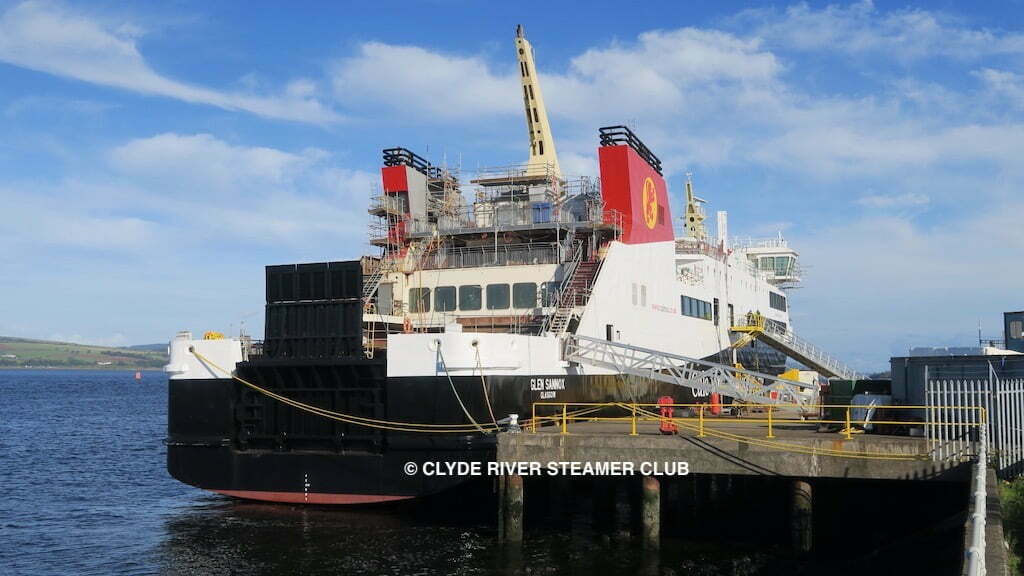
MV Glen Sannox at Port Glasgow on 22 September 2022 — still under construction, five years after launch
A forensic analysis of Scotland’s ‘ferries fiasco’, published in the 22 September edition of the prestigious London Review of Books (LRB), lays the blame for what has gone wrong squarely at the door of the SNP government in Edinburgh. A follow-up article published on 18 October adds further detail.
Written by Ian Jack, an experienced and highly respected journalist with strong Clydeside roots, the LRB study may come to be seen as the definitive piece on the scandal surrounding two unfinished west coast ferries, which were ordered in 2015 and are now expected to cost the taxpayer well over double the original £97m contract price.
One ferry has been sitting immobile in the water at Port Glasgow since 2017, when it was launched by First Minister Nicola Sturgeon with the name Glen Sannox.
The second is still on dry land at the same shipyard — the former Ferguson Brothers site next to Newark Castle. Now known as Ferguson Marine, the yard was nationalised by the Government in 2019 in a deepening imbroglio of accusation and counter-accusation, which continues to bewilder many in Scottish public life — not to mention numerous CRSC members and other shipping enthusiasts.
The controversy, embracing civil servants, a revolving door of managers, the businessman Jim McColl and a raft of Scottish government quangos, has become a long-running soap opera, its evolving dramas and revelations shrouded in obfuscation.
Ian Jack’s long, thoughtful and well-informed piece, which can be viewed here, is by far the most detailed analysis to have been published — and also the most panoramic and clairvoyant in its scope.
He says that ‘few of those involved emerge well from the story, but the charges against the SNP government in Edinburgh are the most serious. Accused of incompetence, evasion and the misuse of taxpayers’ money, Sturgeon and her colleagues have responded by talking about ‘learning lessons’, ‘saving jobs’ and ‘moving on’. [But] The Scottish government commissioned and funded the ships; the Scottish government now owns and manages the shipyard: the Scottish government will subsidise the ships when (though ‘if’ still can’t be ruled out) they are in operation.’
Sturgeon, he adds, must demonstrate that her administration is more competent, transparent and responsive to local needs than the UK government. ‘Scottish contempt for the Westminster political leadership reached new heights under Boris Johnson (and threatens to rise even further under Liz Truss), so this should be easy enough. But the SNP has held power in Scotland for fifteen years and has its own list of embarrassments.’
Next to the SNP government, the villains of the piece appear to be the Edinburgh-based quango Transport Scotland and Derek Mackay, the disgraced former Transport Minister. However, no one has been held accountable.
Although McColl (the displaced shipyard owner who is extensively quoted in Jack’s analysis) is not let off the hook, he emerges relatively unscathed — as does the state-owned ferry operator CalMac Ferries Ltd, which has had no role in the building of the ferries beyond discussion with Caledonian Maritime Assets Ltd (CMAL, the state-owned ferries and ports procurement company) about the requirements for operation. In that light, the only aspect of the LRB piece that is wide of the mark is the headline writer’s reference to ‘the CalMac scandal’.
Jack’s essay is leavened by personal reminiscences of Port Glasgow in the 1950s and his understanding of the historical background of Clyde shipbuilding’s glory days, as well as his fascinating summary of the evolution of services to the Hebrides, with all the accompanying tangle of islander sentiment/resentment.
For readers less familiar with the west of Scotland ferries scene, he clears up one widespread misapprehension — that Caledonian MacBrayne and CalMac Ferries Ltd are somehow synonymous. The latter runs the ferries, yes, but the intellectual property rights of the former (emblazoned on the hull of virtually every ferry) are owned by CMAL. In other words, Caledonian MacBrayne is a brand: the name (and the livery that goes with it) can be sold to whoever wins the contract to operate the ships, whether that be Serco, the sovereign wealth fund of Dubai — or the present incumbent, CalMac Ferries Ltd.
And so, says Jack, ‘the sudden rush of sentiment [in favour of CalMac during the heated debate surrounding contract renewal in 2016] was misplaced. No traditions were imperilled, but jobs were at stake.’
Nevertheless, CalMac — not CMAL or the Government — has been left bearing the brunt of public criticism for recent failings of the west coast ferry network, failings that in many cases are due to delays in ferry procurement outwith its responsibility.
In his concluding paragraph, Jack quotes Ferguson Marine’s new chief executive, David Tydeman, as expressing confidence that the two ferries will be delivered next year, hull 801 (Glen Sannox) between March and May and hull 802 between October and December.
Should we take Tydeman at his word or, in the light of so many previous broken promises, treat such assurances with cynicism? This story has yet to reach the finishing line.
Ian Jack’s LRB article can be read here. It is essential reading for anyone interested in getting to the bottom of the ‘ferries fiasco’.
A short and equally perceptive follow-up article (18 October), drawing on evidence provided by an explosive BBC Scotland documentary broadcast on 27 September, can be read here.

Still friends? Jim McColl and Nicola Sturgeon at the launch of MV Glen Sannox at Port Glasgow on 21 November 2017
Published on 25 September 2022 and updated on 23 October











